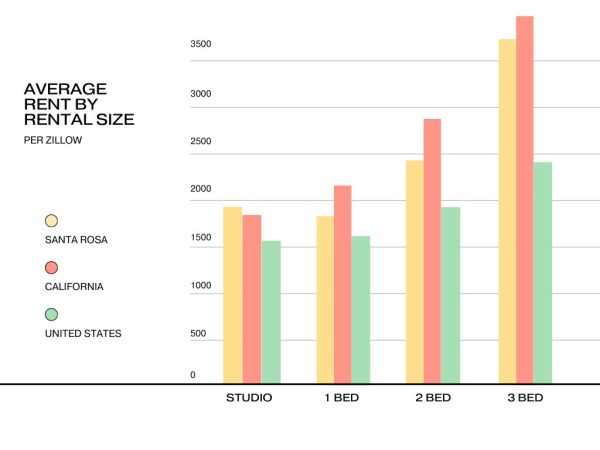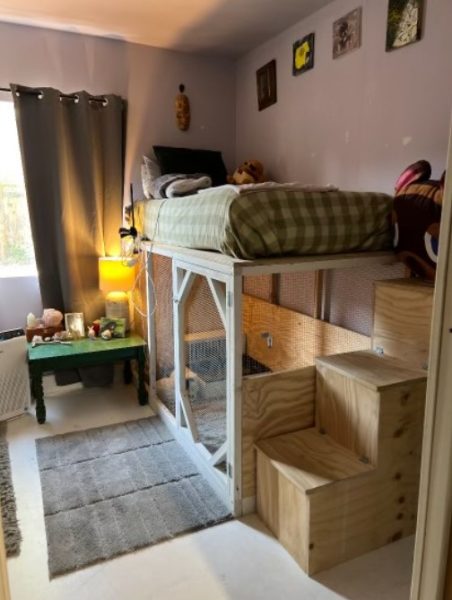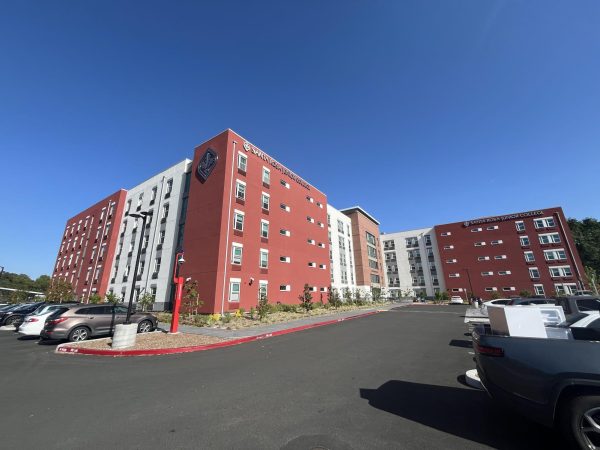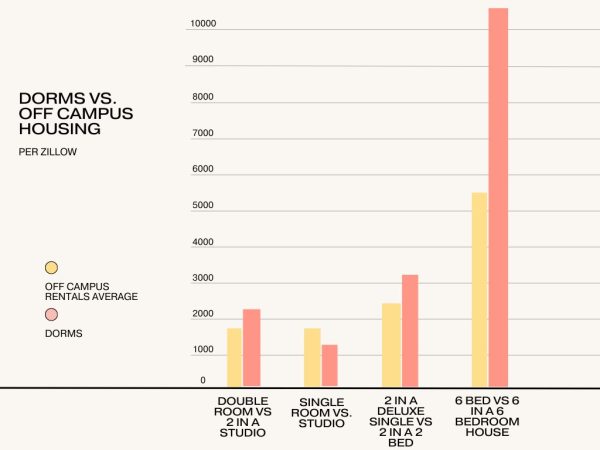In a cold, uninsulated 8-by-8 room built into the garage of her parents’ home, Lizzy Means gets ready for a full day of classes at Santa Rosa Junior College while Frank, another SRJC student who chose to remain anonymous, wakes up in the cramped studio apartment he shares with his pregnant wife.
Though neither Means, 20, nor Frank, 34, are satisfied with their living situation, they know that living in their cars or on the streets is worse. After all, it wasn’t too long ago that Frank experienced homelessness.
With the rising cost of housing in Sonoma County, a comfortable living situation has become increasingly unattainable for SRJC students. According to 2023 SRJC data, a reported 595 students are currently experiencing homelessness. Although SRJC has implemented student housing on campus, only 352 students can inhabit the Polly O’Meara Doyle Hall Dormitory at a time.
College students are not the only ones struggling in Santa Rosa. As of October 2023, CBS News reported that Santa Rosa rose to the eighth most expensive city in the United States, just under Salinas in seventh place and San Francisco in sixth.
From Homeless to Housed
“Imagine going from being a student, to homeless, trying to get on your feet, trying to find a place,” Frank said.
Frank lost his job in the summer of 2018. He lived out of his 2015 Dodge Challenger on and off for the better part of five years, while occasionally having somewhere to stay for around a month at a time. His then-girlfriend, and now-wife, supported him while she lived with her parents, who were unaware of his situation.
“Compared to everybody else who was homeless where I was staying, I was the richest on my block,” Frank said. “I did everything I could to try to survive. I saw crackheads. I saw tweakers. I slept in shifts. I went to bed at 9 p.m., woke up at midnight, stayed up until 3 a.m., went to bed at 3:30, and woke up at 7:30 a.m.”
He worked in shifts to avoid staying in one place for too long, and to stay aware of his surroundings.
Frank worked for a charity as a financial stability case manager from November 2022 to October 2023, helping other homeless people apply for Section 8 housing. Because of high demand, the waitlist for Section 8 housing can take many years.
“While doing all this, I’m still homeless,” Frank said. “I’m getting people into homes. I’m getting them help, but I’m homeless. Unfortunately, what I was getting paid wasn’t enough to survive.”
Frank eventually began to save up enough money to look for housing, though he had initial trouble with the rental process.
“They want good credit. They want you to make three times the amount of rent that they’re asking for. They’re asking you if you have a cosigner. If you don’t, then you’re out of luck,” Frank said. “We went through so many applications and that adds up quickly. $25 here, $30 here, $50 there. Who the hell has $120 to dish out in one day trying to fill out four or five applications?”
Frank and his wife eventually found a home, though their living situation isn’t optimal, especially with a baby on the way.

“I’m renting a studio that’s no more than 300, maybe 350 square feet,” Frank said. “This thing’s dinky. It’s $1,650 a month, and that’s not including bills.”
Frank is currently a full-time biology major, while his wife makes roughly $45,000 a year as a program coordinator at a non-profit.
According to the living wage calculator, the living wage for one single adult in Sonoma County is about $27 an hour. Bringing a child into the mix raises that cost to $49.33. Not earning enough to pay for childcare, he and his wife will have to rely on friends and family to help watch their kid.
Although he acknowledges that his life has not been easy, Frank is thankful to be in an apartment, even if it is cramped. He will never forget his time on the streets.
One of the Lucky Ones
Though Lizzy Means isn’t thrilled with her housing situation, she’s one of the lucky ones. Means has lived in a cramped, cold room built off the side of her parents’ house for the last three years.

“It is really small, and it’s just the wall and then outside,” Means said. “There’s no insulation in my room. It’s all concrete floor. It’s like a garage.”
She had tried to move out on several occasions, but because of her lack of rental history and the increasing price of rent in California, she has been unsuccessful.
The last time she tried was a year ago when she had a place lined up in Eureka — until the landlord increased the rent. Means said the rent had been raised to $1,100 a month, a steep price to pay for those working minimum wage jobs. “As a college student, those few hundred dollars are likely a matter of whether you’re going to eat or not, and I would really like to try to take care of myself.”
Minimum wage in California increased to $16 an hour on Jan. 1, 2024. Sonoma County raised the minimum living wage to $18.10 an hour this year, however, businesses are not required to pay their workers more than the state minimum wage. Though she works for more than minimum wage now, she still finds it difficult to save enough money to move out of her parents’ house.
“Everything’s even more expensive in Sonoma County, so having to budget and then trying to save to move when you make under $20 an hour is really difficult. I think the only way you can do it is if you get a service job. That’s what I do now.” Means said.
She doesn’t pay rent at her parents’ house and has been saving up to be able to transfer to a four-year college. She’s found that saving money is difficult when the prices of essentials like gas and groceries continue to rise.
SRJC Director of Reentry and Student Resources Lily Hunnemeder-Bergfelt said the college has assistance for students in need of housing, such as working with InterFaith Shelter Network.
“The college recently received a new grant through the Chancellor’s Office to support homeless or housing insecure students,” Hunnemeder-Bergfelt said.
“Students with housing issues can fill out the Basic Needs Resource form located on the Student Resource Center web page,” Hunnemeder-Bergfelt said. “When a student submits this form, it goes directly to our social workers, and a few others, who are able to contact the student and make any necessary referrals.”
She also cited on-campus jobs as a way to cover basic needs. Although, student jobs on campus pay less than the county’s minimum wage.
SRJC attempted to address the growing cost of rent and gas by building the new Polly O’Meara Doyle Hall dormitory, however, the rooms failed to act as a cheaper alternative to off campus housing.

Although the dorms include monthly bills into the overall rent, students living in the dorms have to sacrifice space and privacy. Rent is also due to increase by 5% at the beginning of the fall 2024 semester. This 5% increase may not seem like much, but as Means said, every penny counts in this economic climate.
Hopeless
2,266 people are experiencing homelessness in Sonoma County, and 595 of those are SRJC students. Though the college attempts to provide affordable housing for its attendees, student housing is first come first serve.

The median cost of all housing, including owning a home, in Santa Rosa currently sits at about $2,500 a month, according to Zillow. That’s $79 less a month than the median rent in Santa Rosa in 2023.
Sonoma County Board of Supervisors member Chris Coursey admitted to feeling as though he was fighting an uphill battle regarding the cost of living and homelessness in the county.
“We’ve been engaged in that battle of trying to provide more affordable housing,” Coursey said. “At the same time that housing gets more expensive and harder to hold on to, we’ve got a lot of potential rental housing in Sonoma County that’s being used as short-term rentals and second homes.”
Coursey admitted that they only made modest changes to help people stay in their homes after a recent meeting about renter protections.
While the average studio apartment in Santa Rosa is $1710 per month, a full-time minimum wage employee makes $2900 a month. Seeing as it’s conventional wisdom to spend no more than one-third of monthly income on rent, Coursey addressed the unfortunate lack of balance between these figures.
“That’s a statistic that we constantly are faced with,” Coursey said, noting that more than half of Sonoma County renters pay more than 30% of their income a month, and more than half of those are paying more than 50%.
“It’s a huge burden,” he said. “It’s not something that can be fixed just by building more housing. We have to build our economy and create better paying jobs. Our economy is heavily centered toward the service side right now, and low-paid work.”
Although the market has cooled slightly, it’s still burning many Santa Rosa students like Means and Frank. As Coursey summed up, “This is a hard place to survive on low pay.”
“It’s definitely made me who I am today,” Frank said. “Luckily, I was able to step out of it because a lot of people don’t have the luck that I did. I saw people who were homeless, addicted to drugs, and some of them died. They were killed on the street. It is what it is, it is tough. I don’t wish that on anybody.”







